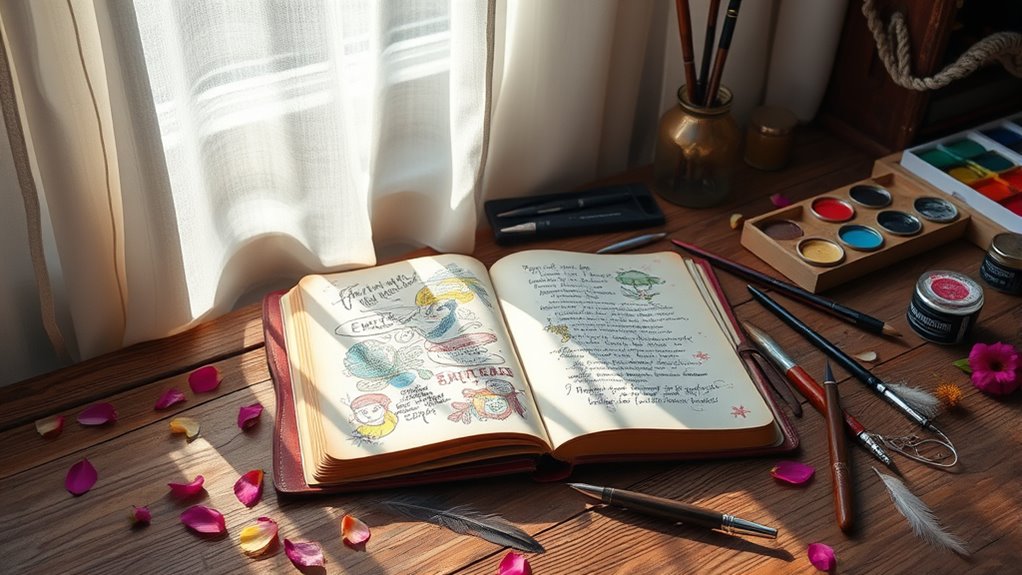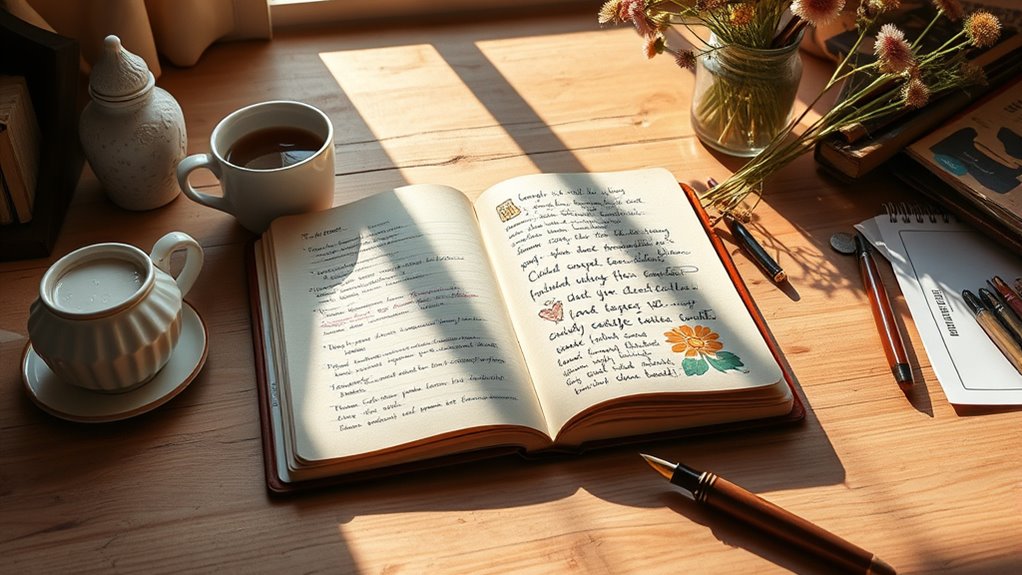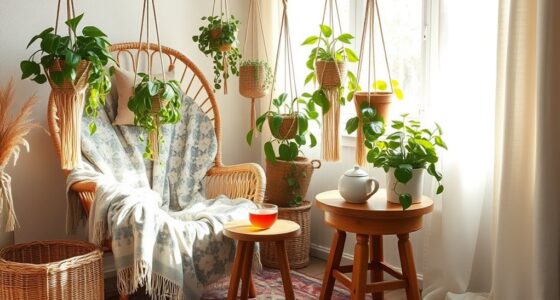Creative journaling is perfect for free spirits like you, offering a way to explore your inner thoughts through spontaneous writing and intuitive doodling. It encourages authentic self-expression by breaking free from strict structures, helping you access subconscious feelings and ideas. As you experiment with patterns, colors, and shapes, you’ll discover deeper layers of yourself and nurture your creative flow. Keep exploring these techniques, and you’ll find more ways to unleash your unique inner world.
Key Takeaways
- Embrace spontaneous, expressive writing to explore inner thoughts beyond conventional structure.
- Incorporate mindful doodling to foster presence and unlock subconscious insights.
- Use abstract shapes and patterns as symbols of emotional and mental landscapes.
- Combine creative techniques to enhance self-discovery, curiosity, and authentic self-expression.
- Integrate regular creative journaling routines to nurture freedom, spontaneity, and personal growth.

Creative journaling is a powerful way to explore your thoughts, feelings, and ideas through expressive writing. It’s a personal practice that encourages you to connect with your inner world in a free and authentic way. For free spirits, this form of journaling offers an outlet to break free from conventional structure and embrace spontaneity. One effective technique you might enjoy is mindful doodling—where you draw simple, repetitive shapes or patterns without judgment or expectation. This practice helps quiet your mind, allowing ideas to flow naturally while keeping your hands busy. Mindful doodling isn’t about creating perfect art; it’s about cultivating a state of presence, which often release insights you might not access through words alone. When you combine mindful doodling with your journal entries, you create a space for abstract exploration that’s both relaxing and revealing.
As you start to doodle mindfully in your journal, you’ll notice that your drawings become more than just random scribbles—they transform into symbols of your subconscious thoughts. You might find yourself sketching swirling lines, geometric shapes, or freeform blobs that mirror your emotional landscape. These abstract explorations are especially freeing because they don’t demand accuracy or coherence. Instead, they serve as a visual language that complements your writing, helping you express feelings that are hard to put into words. This blend of art and writing lets you access a deeper layer of your inner world. You can experiment with different patterns, colors, or textures, trusting that whatever emerges is valid and meaningful. It’s an intuitive process that encourages spontaneity and curiosity—perfect for anyone who loves to explore without limits.
Incorporating mindful doodling and abstract exploration into your creative journaling routine can be both invigorating and calming. It breaks the monotony of traditional journaling, inspiring you to see your thoughts from new perspectives. You don’t need to be an artist to benefit from this—it’s about engaging with your subconscious and allowing your intuition to guide you. Over time, you’ll notice your doodles becoming more expressive and your writing richer with insights. This practice nurtures your free spirit by validating your unique way of seeing the world. It’s a reminder that creativity doesn’t have to be about perfection; it’s about exploration, self-discovery, and honoring your authentic voice. Incorporating diverse techniques like scenic views can enhance your connection with your environment and inspire fresh ideas. Through mindful doodling and abstract exploration, you’ll craft a journal that’s as wild and wonderful as you are.
Frequently Asked Questions
Can Creative Journaling Help Improve Mental Health?
Yes, creative journaling can improve your mental health by encouraging emotional expression and reducing stress. When you put your thoughts and feelings on paper, you process emotions more effectively. This practice helps you gain clarity, release built-up tension, and feel more centered. By making journaling a regular habit, you’ll find it easier to manage anxiety and improve overall mental well-being.
What Supplies Are Essential for Beginning Creative Journaling?
You need basic art supplies like a sturdy notebook, pens, and colored pencils to start your creative journaling journey. While simple journaling techniques focus on writing, adding paints or markers can bring your pages to life. Imagine blending words with vibrant colors, turning your thoughts into expressive art. These supplies help you explore your inner world freely, making each page a unique reflection of your spirit.
How Often Should I Journal to See Benefits?
You should journal regularly, aiming for a ideal journaling routine of at least 3-4 times a week. Consistent journaling frequency helps you notice benefits like increased clarity and emotional release. Don’t worry about perfect timing; even short sessions make a difference. Stick to a schedule that feels manageable, and over time, you’ll find journaling becoming a natural, empowering part of your routine.
Is Creative Journaling Suitable for All Age Groups?
Think of creative journaling as a universal language that speaks to all ages. It’s highly adaptable, with age appropriateness and accessibility considerations making it suitable for everyone. Whether you’re a child doodling dreams or an adult pouring out thoughts, this practice open(s) your inner voice. So, no matter your stage in life, creative journaling can be tailored to fit your needs, offering a canvas for self-expression and reflection.
Can Creative Journaling Enhance My Spiritual Practice?
Yes, creative journaling can enhance your spiritual practice by fostering artistic expression and self-discovery. As you put pen to paper or colors to canvas, you deepen your connection with your inner self and explore your spiritual beliefs. This process encourages mindfulness, reflection, and emotional release, helping you gain clarity and insight. Regular journaling becomes a sacred space where your spirituality naturally unfolds and grows through your personal artistic journey.
Conclusion
Your creative journal is your garden, a place where your free spirit can bloom without limits. As you nurture each thought and color outside the lines, you cultivate a sanctuary of self-expression and growth. Remember, every stroke and scribble is a seed planted in the rich soil of your mind. Keep tending this garden with love and curiosity, and watch your inner world flourish like a wildflower meadow—beautiful, untamed, and uniquely yours.










